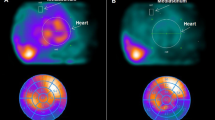Abstract
Background. In patients with cardiac syndrome X (CSX) who present with refractory angina episodes, spinal cord stimulation (SCS) has beneficial effects. The mechanisms of SCS, however, remain speculative. We assessed the effects of SCS on cardiac sympathetic function in these patients.
Methods and Results. We studied 11 CSX patients treated by SCS for refractory angina (mean age, 60±9 years; 5 men and 6 women), both during SCS therapy (SCS-ON) and after withdrawal of SCS therapy (SCS-OFF), using a randomized crossover design. Planar and single photon emission computed tomography iodine 123 metaiodobenzylguanidine (MIBG) myocardial scintigraphy and technetium 99m sestamibi (MIBI) bicycle exercise stress testing were performed at the end of each period. Compared with 10 healthy control subjects, CSX patients showed a lower heart-mediastinum ratio for MIBG uptake (2.19±0.3 vs 1.69±0.3,P=.001) and a higher cardiac MIBG uptake score (4.0±2.5 vs 19.7±27,P=.08). There were no differences in CSX patients during the SCS-ON and SCS-OFF phases of the study in heart-mediastinum ratio (1.74±0.3 vs 1.69±0.3,P=.13), cardiac washout rate of MIBG (42.9%±14% vs 43.3%±14%,P=.08), or MIBG defect score (18.7±25 vs 19.7±27,P=.22). Reversible perfusion defects during the SCS-OFF phase were detected in 8 patients; an improvement in perfusion defects was observed in 2 patients (25%) during the SCS-ON phase.
Conclusions. Our data confirm the presence of abnormal cardiac adrenergic nerve function in CSX patients. SCS was unable to result in significant improvement of cardiac MIBG uptake abnormalities, suggesting that its therapeutic effects are unlikely to be mediated by modulation of cardiac adrenergic nerve activity.
Similar content being viewed by others
References
Lanza GA. Cardiac syndrome X: A critical overview and future perspectives. Heart 2007;93:159–66.
Maseri A, Crea F, Kaski JC, Crake Tl. Mechanisms of angina pectoris in syndrome X. J Am Coll Cardiol 1991;17:499–506.
Montorsi P, Fabbiocchi F, Loaldi A, Fabbiocchi P, Polese A, De Cesare N, et al. Coronary adrenergic hyperreactivity in patients with syndrome X and abnormal electrocardiogram at rest. Am J Cardiol 1991;68:1698–703.
Rosano GMC, Ponikowski P, Adamopoulos S, Collins P, Poole-Wilson PA, Coats AJ, et al. Abnormal autonomic control of the cardiovascular system in syndrome X. Am J Cardiol 1994;73: 1174–9.
Rosen SD, Dritsas A, Bourdillon PJ, Camici PG. Analysis of the electrocardiographic QT interval in patients with syndrome X. Am J Cardiol 1994;73:971–2.
Camici PG, Marracini P, Gistri R, Salvadori PA, Sorace O, L’Abbate A. Adrenergically mediated coronary vasoconstriction in patients with syndrome X. Cardiovasc Drugs Ther 1994;8:221–6.
Meeder JG, Blanksma PK, Crijns HGJM, Anthonio RL, Pruim J, Brouwer J, et al. Mechanisms of angina pectoris in syndrome X assessed by myocardial perfusion dynamics and heart rate variability. Eur Heart J 1995;16:1571–7.
Lanza GA, Giordano AG, Pristipino C, Calcagni ML, Meduri G, Trani C, et al. Abnormal cardiac adrenergic nerve function in patients with syndrome X detected by [123]I-metaiodobenzylguanidine myocardial scintigraphy. Circulation 1997;96:821–6.
Kaski JC, Rosano GMC, Collins P, Nihoyannopoulos P, Maseri A, Poole-Wilson PA. Cardiac syndrome X: Clinical characteristics and left ventricular function. Long-term follow-up study. J Am Coll Cardiol 1995;25:807–14.
Lanza GA, Sestito A, Sgueglia GA, Infusino F, Papacci F, Visocchi M, et al. Effect of spinal cord stimulation on spontaneous and stress-induced angina and ‘ischemia-like’ ST-segment depression in patients with cardiac syndrome X. Eur Heart J 2005;26: 983–9.
Sgueglia GA, Sestito A, Spinelli A, Cioni B, Infusino F, Papacci F, et al. Long-term follow-up of patients with cardiac syndrome X treated by spinal cord stimulation. Heart 2007;93:591–7.
Chauhan A, Mullins PA, Thuraisingham SI, Taylor G, Petch MC, Schofield PM. Effect of transcutaneous electrical nerve stimulation on coronary blood flow. Circulation 1994;89:694–702.
Giordano A, Calcagni ML, Rufini V, Colivicchi F, Melina D, Melina G, et al. Use of [123I]MIBG to assess cardiac adrenergic innervation: Experience in hypertensive cardiopathy and left ventricular aneurysms. Q J Nucl Med 1995;39(Suppl 1):44–8.
Yamashina S, Yamazaki J-I. Neuronal imaging using SPECT. Eur J Nucl Med Mol Imaging 2007;34(Suppl 1):S62–73.
Shapiro LM, Crake T, Poole-Wilson PA. Is altered cardiac sensation responsible for chest pain in patients with normal coronary arteries? Clinical observation during cardiac catheterization. Br Med J (Clin Res Ed) 1988;296:170–1.
Cannon RO III, Quyyumi AA, Schenke WH, Fananapazir L, Tucker EE, Gaughan AM, et al. Abnormal cardiac sensitivity in patients with chest pain and normal coronary arteries. J Am Coll Cardiol 1990;16:1359–66.
Pasceri V, Lanza GA, Buffon A, Montenero AS, Crea F, Maseri A. Role of abnormal pain sensitivity and behavioral factors in determining chest pain in syndrome X. J Am Coll Cardiol 1998;31:62–6.
de Vries J, Dejongste MJ, Durenkamp A, Zijlstra F, Staal MJ. The sustained benefits of long-term neurostimulation in patients with refractory chest pain and normal coronary arteries. Eur J Pain 2007;11:360–5.
Jessurun GA, Hautvast RW, Tio RA, DeJongste MJ. Electrical neuromodulation improves myocardial perfusion and ameliorates refractory angina pectoris in patients with syndrome X: Fad or future? Eur J Pain 2003;7:507–12.
Sanderson JE, Woo KS, Chung HK, Chan WW, Tse LK, White HD. The effect of transcutaneous electrical nerve stimulation on coronary and systemic haemodynamics in syndrome X. Coron Artery Dis 1996;7:547–52.
Eliasson T, Albertsson P, Hardhammar P, Emanuelsson H, Augustinsson LE, Mannheimer C. Spinal cord stimulation in angina pectoris with normal coronary arteriograms. Coron Artery Dis 1993;4:819–27.
Norrsell H, Eliasson T, Mannheimer C, Augustinsson LE, Bergh CH, Andersson B, et al. Effects of pacing-induced myocardial stress and spinal cord stimulation on whole body and cardiac norepinephrine spillover. Eur Heart J 1997;18:1890–6.
Eliasson T, Augustinsson LE, Mannheimer C. Spinal cord stimulation in severe angina pectoris—presentation of current studies, indications and clinical experience. Pain 1996;65:169–79.
Rosen SD. The pathophysiology of cardiac syndrome X—a tale of paradigm shifts. Cardiovasc Res 2001;52:174–7.
Author information
Authors and Affiliations
Corresponding author
Rights and permissions
About this article
Cite this article
Spinelli, A., Lanza, G.A., Calcagni, M.L. et al. Effect of spinal cord stimulation on cardiac adrenergic nerve function in patients with cardiac syndrome X. J Nucl Cardiol 15, 804–810 (2008). https://doi.org/10.1007/BF03007362
Received:
Revised:
Issue Date:
DOI: https://doi.org/10.1007/BF03007362




